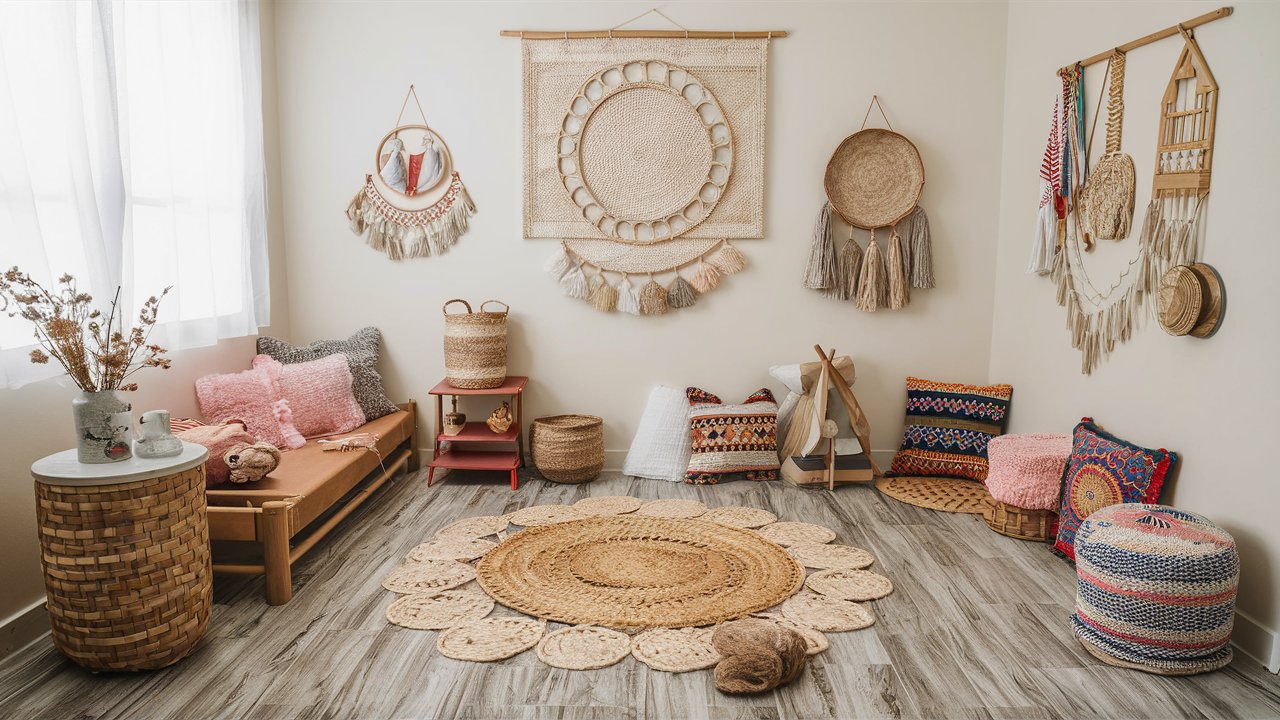Disclosure: Some links on this site are affiliate links. As Amazon Associates, we earn from qualifying purchases (at no cost to you).
Ready to transform your child’s play area into a Montessori-inspired haven? Creating a playroom that encourages independence, creativity, and learning doesn’t have to be complicated or expensive.
Whether you have a toddler, baby, a small space, or a bohemian style in mind, these 15 simple Montessori playroom ideas will inspire you to create an engaging and beautiful environment for your little ones.
15 Fantastic Montessori Playroom Ideas
1. Low Shelves
Install low, accessible shelves so toddlers can easily reach their toys and books. This promotes independence and allows children to make choices about their activities.

Opt for wooden shelves that are sturdy and blend seamlessly with the playroom decor. Keeping the shelves organized and not overcrowded encourages kids to put items back in their place.
2. Natural Light
Utilize natural light as much as possible to create a bright and welcoming playroom. Large windows with sheer curtains allow sunlight to fill the room, boosting mood and energy levels.

Position play areas near windows to make the most of natural light and consider using light-colored walls to reflect light and keep the space airy.
3. Neutral Colors
Opt for a neutral color palette with pops of muted tones to create a calm and serene environment. Soft whites, beiges, and pastels can make the room feel peaceful and focused.

Accent pieces in pastel pinks, blues, or greens add just the right amount of color without overwhelming the senses.
4. Floor Mats and Rugs
Soft floor mats and rugs provide a comfortable play area for children. Choose natural fibers like cotton or wool for a sensory-friendly experience.

Mats with playful designs can also serve as learning tools, with shapes, numbers, or letters integrated into the patterns.
5. Minimalist Design
Keep the playroom clutter-free with a minimalist design. A simple layout with fewer toys encourages more meaningful play and helps children focus on one activity at a time.

Use multi-functional furniture to save space and maintain a clean, organized look.
6. Open-Ended Toys
Invest in open-ended toys that can be used in various ways, such as wooden blocks, dolls, and art supplies. These toys foster creativity, problem-solving, and critical thinking.

Avoid toys with a single purpose or too many electronic features, as they can limit imaginative play.
7. Reading Nook
Create a cozy reading nook with comfortable seating like bean bags or small armchairs and a low bookshelf stocked with age-appropriate books.

This space encourages a love for reading from an early age. Adding soft lighting and pillows makes it an inviting spot for quiet time and story sessions.
8. Low Table and Chairs
Provide a low table and chairs set for activities like drawing, puzzles, and crafts. This setup allows toddlers to sit comfortably and work independently.

Ensure the table and chairs are sturdy and appropriately sized for little ones to foster a sense of ownership and responsibility.
9. Wall Art and Decor
Use educational wall art and simple decor to reflect the child’s interests and cultural background. This can include maps, alphabet charts, or art that depicts nature and animals.

Keeping the decor at eye level for children makes the room more engaging and relatable.
10. Montessori Mobiles
Hang Montessori mobiles above the baby’s play area. These mobiles are designed to stimulate visual development and are perfect for infants.

Choose mobiles with contrasting colors and simple shapes to capture the baby’s attention and encourage visual tracking.
11. Nature Elements
Incorporate elements of nature, such as indoor plants, wooden toys, and natural fabrics. This brings a sense of tranquility and connection to the natural world.

Nature-themed play items like rocks, leaves, and shells can be great for sensory exploration.
12. Mirrors
Add low-hanging mirrors to the playroom. Mirrors help babies and toddlers explore movement, develop self-awareness, and understand spatial relationships.

Ensure the mirrors are shatterproof and securely mounted to the wall for safety.
13. Accessible Storage
Use baskets and bins for easy-to-access storage. Label them with pictures and words to teach organization skills and word recognition.

Clear containers can also be helpful so children can see what’s inside, making it easier for them to find and put away their toys.
14. Soft Lighting
Install soft, adjustable lighting like fairy lights or a dimmable lamp to create a warm and inviting atmosphere.

Soft lighting is perfect for creating a calming environment for playtime and can be adjusted for different activities and times of day.
15. Bohemian Touches
Add a bohemian flair with textured rugs, woven baskets, and colorful cushions. This style adds personality and warmth to the space, making it feel cozy and unique.

Incorporate handmade or artisanal items to enhance the bohemian vibe and create a more personalized playroom.
FAQ
Q: What is the main principle of a Montessori playroom? A: A Montessori playroom focuses on creating a child-friendly environment that promotes independence, exploration, and learning through simple, accessible, and natural elements.
Q: How do I keep a Montessori playroom organized? A: Use low shelves, labeled baskets, and bins to keep toys and materials organized and within reach. Rotate toys regularly to maintain interest and reduce clutter.
Q: Can I create a Montessori playroom in a small space? A: Absolutely! Focus on essential elements like low shelves, a reading nook, and a small table and chairs. Utilize vertical space and keep the design minimalist to maximize the area.
Q: What types of toys are best for a Montessori playroom? A: Choose open-ended toys made from natural materials, such as wooden blocks, dolls, art supplies, and sensory items. These encourage creativity and problem-solving.
Final Thoughts
Creating a Montessori playroom doesn’t have to be complicated or costly. By incorporating these 15 simple ideas, you can design a space that nurtures your child’s growth, independence, and creativity.
Remember, the key is to keep it simple, natural, and accessible.
Your little ones will love their new playroom, and you’ll enjoy watching them learn and explore in a thoughtfully designed environment!


